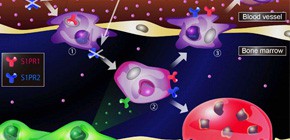
Elucidation of role for active Vitamin D in maintenance of bone homeostasis
Under the leadership of KIKUTA Jun-ichi , Assistant professor, and ISHII Masaru , Associate Professor, Immunology Frontier Research Center (IFReC), Osaka University, a group of researchers clarified that active vitamin D inhibited bone osteoclast resorption by reducing S1PR2 receptor activity.
In the process of clarifying the above, the group used intravital two-photon microscopy to visualize activity in bone tissue in vivio for the first time in the world. They clarified, in particular, the process through which the migration of osteoclast precursers, macrophage-like cells in blood, was regulated by Sphingosine 1-phosphate (S1P). Osteoclast precursors express bidirectional S1P receptors, S1PR1 and S1PR2. Osteoclast precursor migration is regulated reciprocally by these two receptors. While S1PR1 mediates chemoattraction toward S1P in bone tissues, S1PR2 mediates chemorepulsion.
This group tested a hypothesis that active vitamin D was involved in the regulation of osteoclasts precursors. They found that administration of calcitriol played a role in controlling the migratory behavior of circulating osteoclast precursors.
This group also found that active vitamin D reduced the expression of S1PR2.
This group's discovery clarified a role of active vitamin D in therapeutical applications. Thus, the development of active vitamin D analogs with increased effectiveness for several human diseases in addition to bone diseases is expected.
Abstract
The migration and positioning of osteoclast precursor monocytes are controlled by the blood-enriched lipid mediator sphingosine-1- phosphate (S1P) and have recently been shown to be critical points of control in osteoclastogenesis and bone homeostasis. Here, we show that calcitriol, which is the hormonally active form of vitamin D, and its therapeutically used analog, eldecalcitol, inhibit bone resorption by modulating this mechanism. Vitamin D analogs have been used clinically for treating osteoporosis, although the mode of its pharmacologic action remains to be fully elucidated. In this study, we found that active vitamin D reduced the expression of S1PR2, a chemorepulsive receptor for blood S1P, on circulating osteoclast precursor monocytes both in vitro and in vivo. Calcitriol- or eldecalcitol-treated monocytoid RAW264.7 cells, which display osteoclast precursor-like properties, migrated readily to S1P. Concordantly, the mobility of circulating CX3CR1+ osteoclast precursor monocytes was significantly increased on systemic administration of active vitamin D. These results show a mechanism for active vitamin D in controlling the migratory behavior of circulating osteoclast precursors, and this action should be conducive to limiting osteoclastic bone resorption in vivo.






To learn more about this research, please download the full research report entitled " Sphingosine-1-phosphate-mediated osteoclast precursor monocyte migration is a critical point of control in antibone-resorptive action of active vitamin D " at this page on the PNAS website.
Related links :
